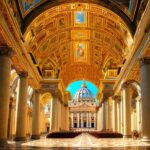This article explores the life and artistic evolution of Ronnie Landfield, a prominent figure in American abstract painting. From his early explorations in Lyrical Abstraction to his mature integrations of modernist traditions, Landfield’s journey provides a fascinating look at the development of a unique artistic voice.
The Genesis of an Abstract Vision
Ronnie Landfield, born in the Bronx, New York, on January 9, 1947, embarked on his artistic path at a young age. This early passion led him to study at the Kansas City Art Institute and the San Francisco Art Institute, providing a foundation for his later explorations. His upbringing in an urban setting presents a compelling contrast to the natural landscapes that would later become central to his artistic vision. Imagine a young Landfield, amidst the bustling city, already envisioning the vast, abstract landscapes he would later bring to life on canvas.
Landfield’s early career, spanning the mid-1960s and 1970s, placed him at the forefront of several influential movements, including Lyrical Abstraction, Postminimalism, and Color Field painting. He found early success, exhibiting in Manhattan in 1962 and gaining representation by the David Whitney Gallery and André Emmerich Gallery. During this period, he experimented with a variety of approaches, from minimal art and sculpture to hard-edge geometric painting and the incorporation of found objects. He even created a series of fifteen mystical “border paintings,” each measuring an impressive 9′ x 6′. Key works from this era, such as The Howl of Terror (1967), Something Else (1967), and Diamond Lake (1969), showcase his early explorations of color, form, and emotional expression. Notably, Diamond Lake was acquired by the Museum of Modern Art (MoMA) in 1972, indicating early recognition of his artistic potential. This period suggests an artist restlessly seeking his unique voice, exploring various avenues of expression before settling on his signature style.
Landscapes of the Mind: The Southwest Influence
In 1973 and 1975, Landfield embarked on transformative journeys through the American Southwest. This experience profoundly impacted his artistic vision, leading him to explore landscape through an increasingly abstract lens. He began painting on both canvas and limestone, inspired by the vibrant colors, vast spaces, and unique light of the region. This period saw the creation of Portal To Paradise, a key work that captures the essence of the Southwestern landscape through its dynamic composition and vibrant hues. Landfield wasn’t simply painting what he saw; he was translating the feeling of the place, the vastness of the sky, the rugged beauty of the terrain, into an abstract language of color and form. His travels and collaborative work with his wife and fellow artists Peter Young and Carmen Megeath likely further enriched his understanding of the interconnectedness of art and life.
A Mature Vision: Bridging Abstraction and Representation
From 1994 to the present, Landfield’s work has reflected a synthesis of his earlier explorations, integrating modernist traditions with the influence of the Southwest and a growing concern for environmental issues. Key works from this period, including Nightfall (1994) and Rite of Spring (1985), showcase a mature artistic vision that bridges the gap between abstraction and representation. These later paintings often incorporate a greater sense of depth and atmospheric perspective, hinting at recognizable forms while retaining the emotional power of abstraction. They invite the viewer to contemplate not just the beauty of nature but also its fragility and the interconnectedness of all things. Landfield’s artistic statement isn’t just visual; it’s a reflection on humanity’s relationship with the natural world.
Beyond his studio practice, Landfield has actively engaged with the art community. He presided over public panel discussions titled “Cool and Collected or Too Hot to Handle” at the New York Studio School and the Tenri Institute, exploring the complexities of contemporary art. He also curated the exhibition “Seven Painters” at the Tenri Institute, demonstrating his commitment to fostering artistic dialogue and supporting his fellow artists. This suggests that Landfield sees himself not just as a creator but also as a contributor to the larger conversation about art’s role in society.
The Innovative Pour: Landfield’s Technique
Central to Landfield’s artistic process is his innovative pouring technique. Unlike traditional brushwork, Landfield often pours acrylic paints directly onto the canvas, allowing them to flow and interact, creating a sense of movement and depth. This method, enabled by the fluidity and vibrancy of Golden acrylics, invented by Sam Golden, became a signature element of his artistic identity. The controlled chaos of this technique allows for a unique interplay between intention and chance, resulting in dynamic compositions that suggest landscapes, vast skies, and bodies of water reflecting light. It’s as if he’s capturing the very essence of nature’s fluidity and ever-changing beauty.
Lyrical Abstraction: A Deeper Dive
Ronnie Landfield is considered a leading figure in Lyrical Abstraction, a movement that emerged in the 1960s and ’70s as a response to both the dominance of Abstract Expressionism and the burgeoning Minimalist and Conceptual art movements. Lyrical Abstraction sought to recapture the emotional intensity of Abstract Expressionism while embracing a more fluid, less overtly gestural approach. Landfield’s work exemplifies this balance, conveying powerful emotions through the interplay of color and form, often evoking the serenity and grandeur of natural landscapes.
It’s important to distinguish between the two distinct trends within Lyrical Abstraction: European Abstraction Lyrique, which originated in post-WWII Paris, and American Lyrical Abstraction, which flourished in New York, Los Angeles, Washington D.C., Toronto, and London from the 1960s through the ’70s. While both shared an emphasis on expressive color and a more personal, emotional approach to abstraction, they developed in distinct cultural contexts.
Post-Painterly Abstraction: A Counterpoint
Post-Painterly Abstraction, a term coined by Clement Greenberg in 1964, provides a useful counterpoint to Lyrical Abstraction. While both movements reacted against certain aspects of Abstract Expressionism, they did so in contrasting ways. Post-Painterly Abstraction, as championed by artists like Kenneth Noland and Ellsworth Kelly, emphasized flatness, precise lines, and a detached, intellectual approach, prioritizing formal elements over emotional expression. This focus on clarity and structure contrasts sharply with the more fluid, emotionally charged works of Lyrical Abstractionists like Landfield.
A Legacy of Color and Light
Ronnie Landfield’s impact on the world of abstract art is undeniable. With over 70 solo exhibitions and his work held in prestigious collections worldwide, including MoMA and the Whitney Museum of American Art, his contributions continue to resonate. His paintings invite viewers to connect with the natural world on a visceral level, experiencing the subtle shifts of light, the vastness of space, and the emotional resonance of color. His exploration of color and light may reveal a deep exploration of the spiritual or transcendental elements, hinting at a search for deeper meaning beyond purely aesthetic concerns.
Are you looking for a job? Visit the Muscogee Creek Nation jobs website to find your next opportunity.
Discover the mušu collection and explore the world of music.
- Unlock Water’s Symbolism: A Cross-Cultural Exploration - April 20, 2025
- Identify Black and White Snakes: Venomous or Harmless? - April 20, 2025
- Unlocking Potential: Origins High School’s NYC Story - April 20, 2025















1 thought on “Ronnie Landfield: Exploring the Evolution of an American Abstract Master”
Comments are closed.